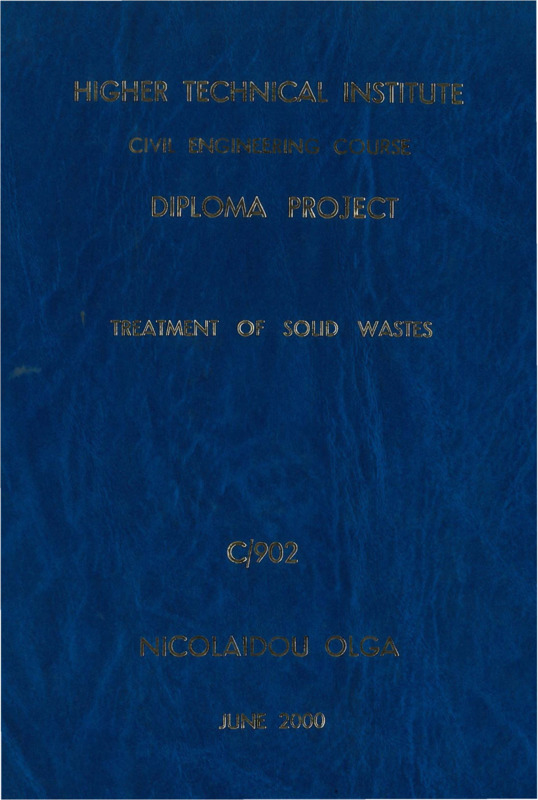Treatment of solid wastes
- Τίτλος
-
Treatment of solid wastes
- Θέμα
- Nature and nurture
- Δημιουργός
-
Nicolaidou, Olga
- Πηγή
- Higher Technical Institute
- Το πλήρες κείμενο είναι διαθέσιμο από το Υπουργείο Ενέργειας, Εμπορίου Βιομηχανίας και Τουρισμού.
- Εκδότης
- Library of Cyprus University of Technology
- Ημερομηνία
- 2000
- Συνεισφέρων
- Kathijotes, N.
- Δικαιώματα
- Απαγορεύεται η δημοσίευση ή αναπαραγωγή, ηλεκτρονική ή άλλη χωρίς τη γραπτή συγκατάθεση του δημιουργού και κάτοχου των πνευματικών δικαιωμάτων.
- Μορφή
- pdg
- Γλώσσα
- en
- Τύπος
- text
- Αναγνωριστικό
-
CED0473
- Σύνοψη
-
Human beings in all civilisations have been sensitive to the importance of the environment to their health and progress. Increasing human population and
the rapid industrialisation of this century have made us realise that respect for a cleaner environment is essential to our survival.
The term solid wastes, contains the heterogeneous mass of throwaways from the urban community as well as the more homogeneous accumulations of agricultural, industrial and mineral wastes. In an urban setting, the centralization of solid wastes is a direct consequence of life.
In the past, the disposal of human and other wastes did not perturb.
The population was less and the available land for the assimilation of wastes was large. Nowadays we talk about recycling, in the past the farmers had no idea about recycling of the energy and fertilizer values of solid wastes.
The disposal of wastes commence to be a problem the time when humans first began to congregate in tribes, villages and communities and the accumulation of wastes became a consequence of life. Throwing of the food
and other solid wastes into streets and roadways, led to the breeding of rats, fleas and as a consistency, diseases such as plague was outbroken.
In the fourteenth century half of the European population was killed by the epidemic of plague, called Black Death.
Until the nineteenth century nobody realized that food wastes had to be collected and disposed of, in a sanitary manner to control the vectors of disease.
Over the past few decades, public awareness of environmental issues has resulted in various federal and state environmental regulations. The primary
aim of these regulations is to protect the human health and the environment.
This means re-mediation of existing waste disposal sites with properly design features.
PROBLEM
Solid wastes are considered a problem to be solved as cheaply as possible rather than a resource to be recovered. Solid wastes disposal creates a problem primarily in highly populated areas. The more concentrated the population, the greater the problem
becomes. In 1990, the EPA estimated that the national average rate of solid wastes generated was 1.9SKg/capta.day. (REF .2)
The relationship between public health and the improper storage, collection and disposal of solid wastes is quite clear. Public health authorities have shown that rats, flies and other disease vectors breed in open dumps, as
well as in poorly constructed or poorly maintained housing in food storage facilities and in many other places where food and harborage are available for
rats and the insects associated with them.
- Πολυμέσα
-
 CED0473.pdf
CED0473.pdf
Τμήμα του Treatment of solid wastes


